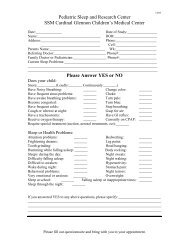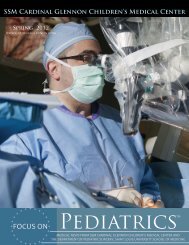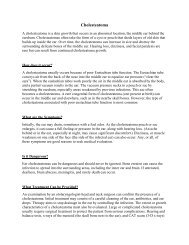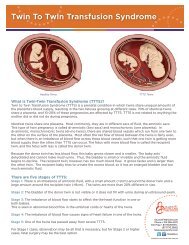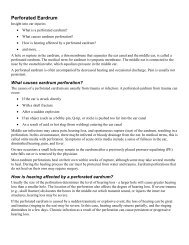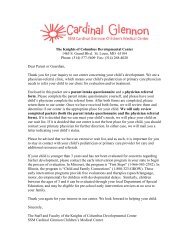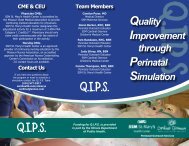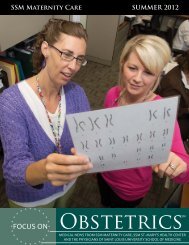pediatric-ALS-AHA-guidelines-circulation_11-2010 - SSM Cardinal ...
pediatric-ALS-AHA-guidelines-circulation_11-2010 - SSM Cardinal ...
pediatric-ALS-AHA-guidelines-circulation_11-2010 - SSM Cardinal ...
You also want an ePaper? Increase the reach of your titles
YUMPU automatically turns print PDFs into web optimized ePapers that Google loves.
Kleinman et al Part 14: Pediatric Advanced Life Support S879airway obstruction, poor lung compliance, or the rescuer hasdifficulty in creating a tight mask-to-face seal. 57,58 Onerescuer uses both hands to maintain an open airway with ajaw thrust and a tight mask-to-face seal while the othercompresses the ventilation bag. Both rescuers should observethe victim’s chest to ensure chest rise.Gastric InflationGastric inflation may interfere with effective ventilation 59 andcause regurgitation, aspiration of stomach contents, andfurther ventilatory compromise. The risk of gastric inflationcan be decreased by● Avoiding excessive peak inspiratory pressures by ventilatingslowly and giving only enough tidal volume to justachieve visible chest rise. 45● Applying cricoid pressure in an unresponsive victim toreduce air entry into the stomach (Class IIa, LOE B). 60–62This may require a third rescuer if cricoid pressure cannotbe applied by the rescuer who is securing the bag to theface. Avoid excessive cricoid pressure so as not to obstructthe trachea (Class III, LOE B). 63● Passing a nasogastric or orogastric tube to relieve gastricinflation, especially if oxygenation and ventilation arecompromised. Pass the tube after intubation because agastric tube interferes with gastroesophageal sphincterfunction, allowing regurgitation during intubation. If agastrostomy tube is present, vent it during bag-maskventilation to allow gastric decompression.Ventilation With an Endotracheal TubeEndotracheal intubation in infants and children requiresspecial training because the <strong>pediatric</strong> airway anatomy differsfrom that of the adult. The likelihood of successful endotrachealtube placement with minimal complications is related tothe length of training, supervised experience in the operatingroom and in the field, 64,65 adequate ongoing experience, 66 anduse of rapid sequence intubation (RSI). 67,68Rapid Sequence Intubation (RSI)To facilitate emergency intubation and reduce the incidenceof complications, skilled, experienced providers may usesedatives, neuromuscular blocking agents, and other medicationsto rapidly sedate and neuromuscularly block the <strong>pediatric</strong>patient. 69Use RSI only if you are trained, and have experience usingthese medications and are proficient in the evaluation andmanagement of the <strong>pediatric</strong> airway. If you use RSI you musthave a secondary plan to manage the airway in the event thatyou cannot achieve intubation.Actual body weight, rather than ideal body weight,should be used for some non-resuscitation medications (eg,succinylcholine). 70–85Cricoid Pressure During IntubationThere is insufficient evidence to recommend routine cricoidpressure application to prevent aspiration during endotrachealintubation in children. Do not continue cricoid pressure if itinterferes with ventilation or the speed or ease of intubation(Class III, LOE C). 86,87Cuffed Versus Uncuffed Endotracheal TubesBoth cuffed and uncuffed endotracheal tubes are acceptablefor intubating infants and children (Class IIa, LOE C). In theoperating room, cuffed endotracheal tubes are associated witha higher likelihood of correct selection of tube size, thusachieving a lower reintubation rate with no increased risk ofperioperative complications. 88–90 In intensive care settings therisk of complications in infants and in children is no greaterwith cuffed tubes than with noncuffed tubes. 91–93 Cuffedendotracheal tubes may decrease the risk of aspiration. 94 Ifcuffed endotracheal tubes are used, cuff inflating pressureshould be monitored and limited according to manufacturer’sinstruction (usually less than 20 to 25 cm H 2 O).In certain circumstances (eg, poor lung compliance, highairway resistance, or a large glottic air leak) a cuffedendotracheal tube may be preferable to an uncuffed tube,provided that attention is paid to endotracheal tube size,position, and cuff inflation pressure (Class IIa, LOE B). 88,91,92Endotracheal Tube SizeLength-based resuscitation tapes are helpful and more accuratethan age-based formula estimates of endotracheal tubesize for children up to approximately 35 kg, 77,95,96 even forchildren with short stature. 97In preparation for intubation with either a cuffed or anuncuffed endotracheal tube, confirm that tubes with an internaldiameter (ID) 0.5 mm smaller and 0.5 mm larger than theestimated size are available. During intubation, if the endotrachealtube meets resistance, place a tube 0.5 mm smaller instead.Following intubation, if there is a large glottic air leak thatinterferes with oxygenation or ventilation, consider replacing thetube with one that is 0.5 mm larger, or place a cuffed tube of thesame size if an uncuffed tube was used originally. Note thatreplacement of a functional endotracheal tube is associated withrisk; the procedure should be undertaken in an appropriatesetting by experienced personnel.If an uncuffed endotracheal tube is used for emergencyintubation, it is reasonable to select a 3.5-mm ID tube for infantsup to one year of age and a 4.0-mm ID tube for patients between1 and 2 years of age. After age 2, uncuffed endotracheal tubesize can be estimated by the following formula:Uncuffed endotracheal tube ID (mm)4(age/4)If a cuffed tube is used for emergency intubation of an infantless than 1 year of age, it is reasonable to select a 3.0 mm IDtube. For children between 1 and 2 years of age, it isreasonable to use a cuffed endotracheal tube with an internaldiameter of 3.5 mm (Class IIa, LOE B). 89,98–100 After age 2 itis reasonable to estimate tube size with the following formula(Class IIa, LOE B: 89,98–101 ):Cuffed endotracheal tube ID (mm)3.5(age/4)Verification of Endotracheal Tube PlacementThere is a risk of endotracheal tube misplacement (ie, in theesophagus, the pharynx above the vocal cords, or a mainstembronchus) and an ongoing risk of displacement or obstruction,45,102 especially during patient transport. 103 Since nosingle confirmation technique, including clinical signs 104 orDownloaded from circ.ahajournals.org by on October 20, <strong>2010</strong>



